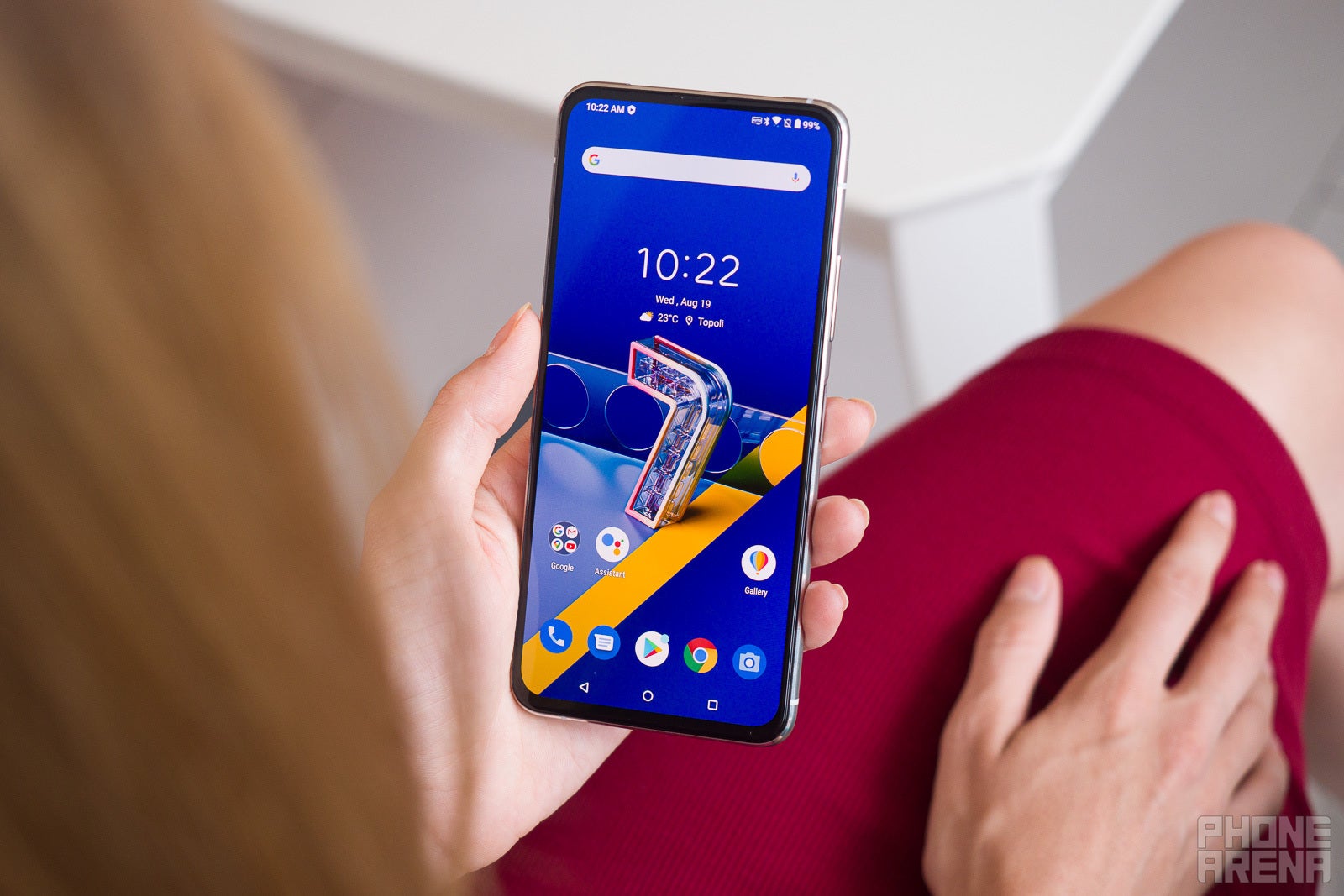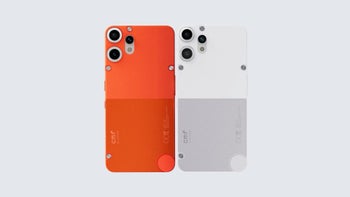Asus ZenFone 7 Pro Review

Design and display
Those of you familiar with the ZenFone 6 will spot the similarities with the new iteration right away. One of the key features Asus is going for with the ZenFone lineup is the edge-to-edge display. The ZenFone 7 Pro sports a big, 6.67-inch AMOLED panel not interrupted by cutouts or notches allowing for a 92% screen-to-body ratio. The bezels are uniform around the edge with the bottom one slightly thicker.

What about the selfie camera then? Well, that’s the second and maybe the most distinctive feature in the Asus ZenFone series. The ZenFone 7 Pro sports a flip camera system (just like its predecessor) that flips up to take up selfie duties when needed. It’s an interesting solution to the selfie camera problem and we’ll talk about it in more detail later on. It’s worth mentioning that there’s a notification light on the bottom of the phone. It’s another interesting feature that can actually be rather useful.
The body of the ZenFone 7 Pro is a glass and metal sandwich with the mid-frame made from a single block of aluminum. It’s a big and thick phone that weighs more than 230 grams. Asus has its own priorities and understanding when it comes to specs and the battery capacity is at the top of the list. The ZenFone 7 Pro accounts for its weight and size with a huge 5000 mAh battery. Wireless charging is missing and it's another trade-off made by Asus in order to maximize capacity. One thing missing, though, is water/dust resistance of any sort, so you better be careful handling the phone around water.
The back panel is made of Gorilla Glass 3 and comes in two color flavors: Pastel White and Aurora Black. It’s a gradient design that displays very beautiful hues of pink and purple when viewed from a certain angle. There’s Gorilla Glass 6 on the front, protecting the gorgeous AMOLED display (made by Samsung and tuned by PixelWorks, by the way). Speaking of which...
The big and bright AMOLED display is а gorgeous 20:9, 6.67” FHD+ (2400x1080) HDR+ panel that’s a pleasure to look at. It supports refresh rates up to 90 Hz for a smooth viewing experience. During our tests, we recorded 686 nits brightness on Auto, which is close to the 700 nits quoted by Asus. There are several display modes you can choose from - Natural, Cinematic, and Standard. If you want the most accurate colors, you have to go with Standard mode (oddly, the Natural setting produces a colder tone overall and a bigger shift in dE).
The Asus ZenFone 7 Pro display is tuned by PixelWorks to deliver top-notch performance. Here are some of the bonus perks you get with this treatment.
Overall, the screen of the Asus ZenFone 7 Pro impresses and the lack of eyesores like notches or cutouts further enhances the uninterrupted viewing experience. When PixelWorks are involved, the results speak for themselves. There’s not much left to be desired from this AMOLED panel, it’s absolutely flagship-grade.
- Absolute Color Accuracy – Every ZenFone 7 is factory tuned with high-efficiency calibration software and runs Pixelworks color management software to optimize power while delivering color accuracy for all apps and content spanning the sRGB and DCI-P3 color gamuts.
- DC Dimming – Reduces eye strain and visual sensitivity that can occur at low brightness on Samsung OLED screens. To dim the screen, the Pixelworks solution dynamically adjusts the display’s current to reduce the screen flickering associated with conventional Pulse Width Modulation (PWM) dimming.
- High-Efficiency Calibration – Each device is efficiently tuned during production using Pixelworks technology and a rapid, high-precision color checker to calibrate for standard sRGB and DCI-P3 color gamuts in a fraction of the time of other approaches.
- Industry-leading HDR – PixelWorks’ precision HDR tone mapping provides exceptional contrast and color depth with up to 1 billion hues and access to more HDR content with certification from top content providers, including Amazon, Netflix, and YouTube
Overall, the screen of the Asus ZenFone 7 Pro impresses and the lack of eyesores like notches or cutouts further enhances the uninterrupted viewing experience. When PixelWorks are involved, the results speak for themselves. There’s not much left to be desired from this AMOLED panel, it’s absolutely flagship-grade.
Camera
Asus has refined the motorized system that rotates the cameras on the horizontal axis, adding more power to the stepper motor and also improving durability. According to the company, the ZenFone 7 Pro can endure up to 200 000 flips. That’s 100 flips per day for more than 5 years. The whole flip system is made of metal which adds to the weight of the phone but it feels quite solid and there’s a nice reassuring machine sound when the gears in the motor start to spin.
The camera system in the Asus ZenFone 7 Pro packs a serious punch. Images turn out detailed and with great dynamic range. The main 64MP shooter takes care of almost everything you can throw at it, producing pleasant results with natural colors and lots of detail. The ultra-wide-angle camera does a decent job and there’s no shift in colors when you switch back and forth between the main camera and the ultra-wide-angle snapper.
Although we were genuinely impressed with the Night mode, one strange artifact appears when shooting very bright objects at night. A mirror image of the bright object can be seen, faintly hovering in the background of the shot. This probably has something to do with the physical construction of the camera system itself but might as well be cured with a software update.
Of course, all the power of the flip camera system is readily available when you want to take a selfie. It might just be the best selfie camera we’ve tested so far, but that’s borderline cheating because you know - it’s technically the main camera system you’re staring into. You can use the ultra-wide-angle lens in selfie mode too, cramming all your buddies into the picture. The dedicated Portrait mode works well, and you can even use the telephoto camera for selfie purposes if you want to check for a photo bomber in the background before taking that perfect shot.
The Flip system seems very solid and you can manually operate it or add up to three custom presets for the flip angle. We’re not sure there are lots of practical uses for this, though. Maybe when you want to take night sky shots without straining your neck or record a video while holding the phone horizontally. It’s an added bonus, nevertheless. The camera app itself is very thorough and easy to use at the same time.

You can manually operate the flip system
Asus has put a lot of work into making the ZenFone 7 Pro a camera phone and it has succeeded. All the necessary modes and options are present, neatly organized, and easy to access. There’s an AI scene detection system, an automatic night scene shooting detection, a PRO mode, pre-autofocus, tracking autofocus, HDR, panorama, and much more.
Video recording is also top-notch on the Asus ZenFone 7 Pro. You can shoot in resolutions from 1080p right up to 8K. When shooting in FullHD you can switch between the main camera and the ultra-wide-angle camera seamlessly in-video. The optical image stabilization is professional grade stuff. You can run a 200 m sprint and it will look like gliding in a cruise ship. There’s a slo-mo shooting mode up to 480 frames per second, a timelapse mode, and motion tracking. The last one is quite interesting - you choose an object and the system will track it around the frame, zooming in and out when necessary. It works well in good lighting conditions.


Software and performance
The Asus ZenFone 7 Pro uses the latest Qualcomm Snapdragon 865+ platform. It consists of eight Kryo 585 CPU cores running at 3.1GHz and an Adreno 650 GPU module. Needless to say, this phone is a real powerhouse and delivers a snappy performance in day to day use. Benchmark scores are topping the charts, too. The ZenFone 7 Pro is one of the fastest phones out there, and not only on paper. With plenty of RAM and internal storage and support for up to 2TB microSD cards, you won’t have any issues on the performance front.
On the software side of things, the phone runs Android 10 with Asus’ proprietary ZenUI 7 on top. It packs some nice features, especially the advanced battery care functionality which allows you to set charging limits, activate slow charging, and get feedback about your charging habits. Apart from the four standard battery modes - High Performance, Standard, Power Saving, and Super Saving, there are two customizable ones that users can tailor to their specific needs.

The ZenFone 7 Pro uses a side-mounted fingerprint scanner that’s integrated with the power button. The latter is actually called a Smart key and allows you to customize double presses and press-and-hold actions. You can use the button to access any app or a system feature like Google Assistant, Turn on/off Wi-Fi, Hotspot, Bluetooth, Do not disturb, Auto-rotate, Flashlight, take a screenshot, retract the camera or switch between sound modes.

The side-mounted fingerprint scanner
Face recognition is on-board if you want an alternative way to secure your ZenFone 7 Pro but bear in mind that it requires the flip camera to… well, flip-up into position, and that can take some time. It’s annoying and not very convenient, so we advise you to stick to the fingerprint reader, for it’s extremely fast and very accurate.
Battery life
The battery life on this phone is amazing. The 5000 mAh capacity was enough for the ZenFone 7 Pro to top our YouTube test with a result of nearly 15 hours of continuous video playback. The Browsing test result turns out respectable as well, even with a 90Hz display refresh rate activated. The Asus ZenFone 7 Pro supports fast charging and you get a 30W brick in the box. By the way, there are two back covers included in the retail package - a transparent hardcover and an Active case. The latter has a little latch on the back that lets you lock the camera in place.
European pricing;
ZenFone 7 Pro : €799 (865+, 8GB RAM, 256GB storage, OIS)
ZenFone 7 : €699 (865, 8GB RAM, 128GB storage, no OIS)
ZenFone 7 Pro : €799 (865+, 8GB RAM, 256GB storage, OIS)
ZenFone 7 : €699 (865, 8GB RAM, 128GB storage, no OIS)




























Things that are NOT allowed: